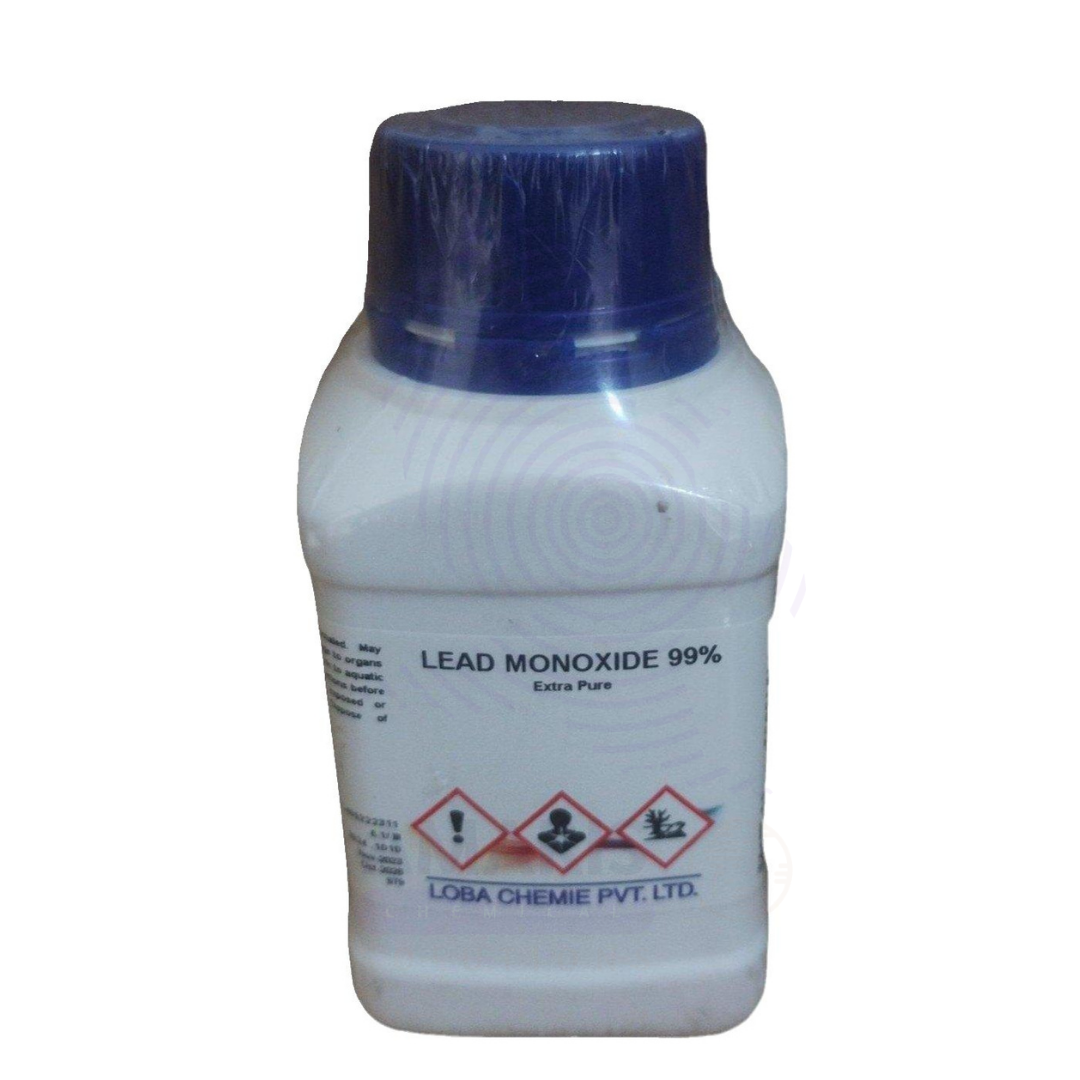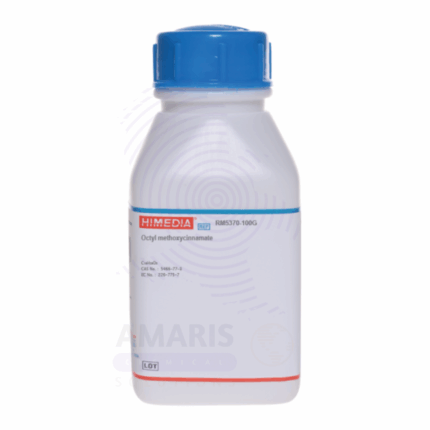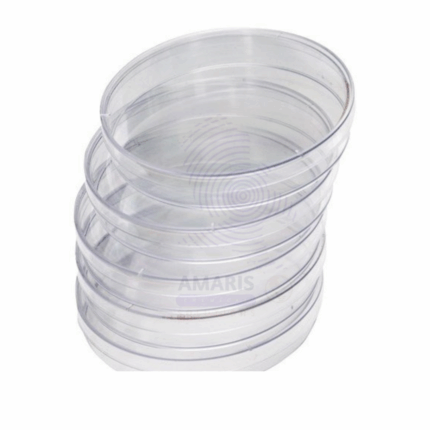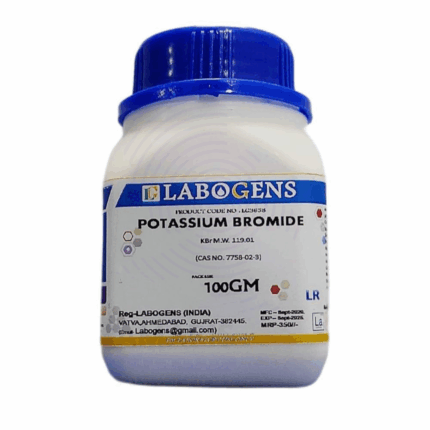
Lead Monoxide Extra Pure
$ 20.00 Original price was: $ 20.00.$ 19.78Current price is: $ 19.78.
Lead Monoxide Extra Pure, also known as litharge (PbO), is a fine yellow or reddish powder widely used in analytical chemistry and industrial processes. Its high purity makes it suitable for laboratory-grade reactions, especially in the manufacture of lead-based compounds, ceramics, glass, and batteries. In the ceramics and glass industries, it enhances the brilliance and stability of glazes and optical glass. In metallurgy, it is used as a fluxing agent during refining. Due to its toxicity and lead content, it requires strict safety handling procedures and controlled storage conditions to prevent contamination or exposure.
Lead Monoxide Extra Pure
Primary Uses
- Glass and Ceramic Formulations:
- Used in the preparation of lead-based glass, ceramic glazes, and enamels, particularly in analytical or materials science research.
- Oxidizing Agent in Synthesis:
- Serves as a mild oxidizing agent in inorganic synthesis and laboratory-scale redox reactions.
- Preparation of Other Lead Compounds:
- Acts as a precursor in the synthesis of lead salts, such as lead acetate or lead nitrate, in controlled lab settings.
Secondary Uses
- Thermal Decomposition Studies:
- Used in studying the thermal behavior of metal oxides and decomposition mechanisms.
- Pigment Research:
- Historically relevant in research on lead-based pigments like litharge (PbO), often studied for toxicity and degradation.
- Battery Chemistry Investigation:
- Sometimes used in academic study related to lead-acid battery chemistry and related corrosion or performance tests.
1. Basic Identification Attributes
- Chemical Name: Lead(II) Oxide
- Synonyms: Litharge, Plumbous oxide
- Chemical Formula: PbO
- CAS Number: 1317-36-8
- Molecular Weight: 223.2 g/mol
- Grade: Extra Pure (analytical/laboratory use)
- Appearance: Yellow or reddish-yellow powder (color depends on crystal form)
- Odor: Odorless
- Solubility: Insoluble in water; soluble in acids and alkalis
- Melting Point: ~888°C
2. Safety & Hazard Attributes
- GHS Classification:
- Acute toxicity (oral) – Category 4
- Reproductive toxicity – Category 1A
- Specific target organ toxicity (repeated exposure) – Category 2
- Hazardous to the aquatic environment – Chronic Category 1
- Hazard Statements:
- H302: Harmful if swallowed
- H360: May damage fertility or the unborn child
- H373: May cause damage to organs through prolonged or repeated exposure
- H410: Very toxic to aquatic life with long lasting effects
- Precautionary Statements:
- P201: Obtain special instructions before use
- P273: Avoid release to the environment
- P280: Wear protective gloves/protective clothing/eye protection
- P301+P312: IF SWALLOWED: Call a POISON CENTER/doctor
- P308+P313: If exposed or concerned: Get medical advice
- Personal Protective Equipment (PPE):
- Safety goggles
- Nitrile gloves
- Lab coat
- Respirator or use under fume hood
- First Aid Measures:
- Inhalation: Move to fresh air; seek medical help
- Skin Contact: Wash skin with soap and water
- Eye Contact: Rinse eyes gently with water for several minutes
- Ingestion: Rinse mouth; do not induce vomiting; seek medical advice
- Fire Hazards:
- Non-combustible
- Emits toxic lead fumes if involved in fire
- Use standard fire extinguishing media for surrounding fire
3. Storage & Handling Attributes
- Storage Conditions:
- Store in a tightly sealed container
- Keep in a cool, dry, and well-ventilated area
- Protect from moisture, acids, and strong oxidizing agents
- Handling Tips:
- Handle under a fume hood
- Avoid dust generation
- Wash thoroughly after handling
- Do not eat, drink, or smoke when using this chemical
4. Laboratory Applications
- Primary Uses:
- Preparation of other lead compounds
- Used in the manufacturing of lead glass and ceramics
- Employed in laboratories for redox and thermal decomposition studies
- Secondary Uses:
- Research in inorganic synthesis
- Pigment precursor (historical) for educational pigment chemistry demonstrations
- Flux in metallurgy and soldering
SAFETY PRECAUTIONS
Personal Protective Equipment (PPE):
- Wear a lab coat, nitrile gloves, and chemical splash goggles.
- Use a NIOSH-approved respirator or work inside a fume hood to avoid inhalation.
Handling:
- Handle in a well-ventilated area and avoid creating or inhaling dust.
- Avoid all contact with skin, eyes, and clothing.
- Wash thoroughly after handling and before eating or drinking.
Storage:
- Store in a tightly closed container in a cool, dry, and well-ventilated location.
- Keep away from acids, oxidizing agents, and moisture.
- Avoid exposure to light and store separately from food or feed materials.
FIRST AID MEASURES
Inhalation:
- Move the person to fresh air immediately.
- Provide oxygen if breathing is difficult.
- Seek medical attention if symptoms persist.
Skin Contact:
- Remove contaminated clothing and rinse skin with plenty of water and soap.
- Get medical attention if irritation or symptoms develop.
Eye Contact:
- Rinse cautiously with water for several minutes.
- Remove contact lenses if it is easy to do so.
- Continue rinsing and seek immediate medical help.
Ingestion:
- Do not induce vomiting.
- Rinse mouth with water.
- Seek emergency medical attention.
- Toxic due to lead content — may cause systemic poisoning.
FIRE FIGHTING MEASURES
Flammability:
- Not flammable, but toxic fumes may be produced in a fire.
Extinguishing Media:
- Use dry chemicals, foam, or carbon dioxide (CO₂).
- Water spray may be used to cool exposed containers.
Hazardous Combustion Products:
- May release lead oxides and irritant gases when heated to decomposition.
Firefighter Protection:
- Wear self-contained breathing apparatus (SCBA) and full protective gear.
- Avoid inhaling smoke or fumes.
Related products
Anhydrous Aluminum Chloride Extra Pure
- SHORT DESCRIPTION


 Preservatives(food)
Preservatives(food) Flavor Enhancers
Flavor Enhancers Acidulants
Acidulants Sweeteners
Sweeteners Antioxidants
Antioxidants Colorants(food)
Colorants(food) Nutraceutical Ingredients (food)
Nutraceutical Ingredients (food) Nutrient Supplements
Nutrient Supplements Emulsifiers
Emulsifiers
 Collectors
Collectors Dust Suppressants
Dust Suppressants Explosives and Blasting Agents
Explosives and Blasting Agents Flocculants and Coagulants
Flocculants and Coagulants Frothers
Frothers Leaching Agents
Leaching Agents pH Modifiers
pH Modifiers Precious Metal Extraction Agents
Precious Metal Extraction Agents
 Antioxidants(plastic)
Antioxidants(plastic) Colorants (Pigments, Dyes)
Colorants (Pigments, Dyes) Fillers and Reinforcements
Fillers and Reinforcements Flame Retardants
Flame Retardants Monomers
Monomers Plasticizers
Plasticizers Polymerization Initiators
Polymerization Initiators Stabilizers (UV, Heat)
Stabilizers (UV, Heat)
 Antifoaming Agents
Antifoaming Agents Chelating Agents
Chelating Agents Coagulants and Flocculants
Coagulants and Flocculants Corrosion Inhibitors
Corrosion Inhibitors Disinfectants and Biocides
Disinfectants and Biocides Oxidizing Agents
Oxidizing Agents pH Adjusters
pH Adjusters Scale Inhibitors( water)
Scale Inhibitors( water)
 Antioxidants(cosmetic)
Antioxidants(cosmetic) Emollients
Emollients Fragrances and Essential Oils
Fragrances and Essential Oils Humectants
Humectants Preservatives
Preservatives Surfactants(cosmetic)
Surfactants(cosmetic) Thickeners
Thickeners UV Filters
UV Filters
 Fertilizers
Fertilizers Soil Conditioners
Soil Conditioners Plant Growth Regulators
Plant Growth Regulators Animal Feed Additives
Animal Feed Additives Biostimulants
Biostimulants Pesticides (Herbicides, Insecticides, Fungicides)
Pesticides (Herbicides, Insecticides, Fungicides)
 Active Pharmaceutical Ingredients (APIs)
Active Pharmaceutical Ingredients (APIs) Excipients
Excipients Solvents(pharmaceutical)
Solvents(pharmaceutical) Antibiotics
Antibiotics Antiseptics and Disinfectants
Antiseptics and Disinfectants Vaccine Adjuvants
Vaccine Adjuvants Nutraceutical Ingredients (pharmaceutical)
Nutraceutical Ingredients (pharmaceutical) Analgesics & Antipyretics
Analgesics & Antipyretics
 Analytical Reagents
Analytical Reagents Solvents(lab)
Solvents(lab) Chromatography Chemicals
Chromatography Chemicals Spectroscopy Reagents
Spectroscopy Reagents microbiology-and-cell-culture-reagents
microbiology-and-cell-culture-reagents Molecular Biology Reagents
Molecular Biology Reagents Biochemical Reagents
Biochemical Reagents Inorganic and Organic Standards
Inorganic and Organic Standards Laboratory Safety Chemicals
Laboratory Safety Chemicals Specialty Laboratory Chemicals(Special Laboratory Equipment)
Specialty Laboratory Chemicals(Special Laboratory Equipment)
 Demulsifiers
Demulsifiers Hydraulic Fracturing Fluids
Hydraulic Fracturing Fluids Scale Inhibitors(oil)
Scale Inhibitors(oil) Surfactants(oil)
Surfactants(oil) Drilling Fluids
Drilling Fluids
 Dyes and Pigments
Dyes and Pigments Bleaching Agents
Bleaching Agents Softening Agents
Softening Agents Finishing Agents
Finishing Agents Antistatic Agents
Antistatic Agents
 Admixtures
Admixtures Waterproofing Agents
Waterproofing Agents Sealants and Adhesives
Sealants and Adhesives Curing Compounds
Curing Compounds Concrete Repair Chemicals
Concrete Repair Chemicals Anti-Corrosion Coatings
Anti-Corrosion Coatings
 Surfactants(cleaning)
Surfactants(cleaning) Builders
Builders Enzymes
Enzymes Solvents (Cleaning)
Solvents (Cleaning) Fragrances
Fragrances
 Electronic Chemicals
Electronic Chemicals Catalysts
Catalysts Lubricants
Lubricants Photographic Chemicals
Photographic Chemicals Refrigerants
Refrigerants Automotive chemicals
Automotive chemicals Pyrotechnic Chemicals
Pyrotechnic Chemicals
 Biodegradable Surfactants
Biodegradable Surfactants Bio-based Solvents
Bio-based Solvents Renewable Polymers
Renewable Polymers Carbon Capture Chemicals
Carbon Capture Chemicals Wastewater Treatment Chemicals
Wastewater Treatment Chemicals
 Pigments
Pigments Solvents(paint)
Solvents(paint) Specialty Coatings
Specialty Coatings Binders/Resins
Binders/Resins Additives
Additives Driers
Driers Anti-Corrosion Agents
Anti-Corrosion Agents Functional Coatings
Functional Coatings Application-Specific Coatings
Application-Specific Coatings
 Fresh Herbs
Fresh Herbs Ground Spices
Ground Spices Whole Spices
Whole Spices Spice Blends
Spice Blends Dried Herbs
Dried Herbs
 Leavening Agents
Leavening Agents Dough Conditioners
Dough Conditioners Flour Treatments
Flour Treatments Fat Replacers
Fat Replacers Decoratives
Decoratives Preservatives(baking)
Preservatives(baking)
 Plasticizers & Softeners
Plasticizers & Softeners Reinforcing Agents
Reinforcing Agents Adhesion Promoters
Adhesion Promoters Vulcanizing Agents
Vulcanizing Agents Antidegradants
Antidegradants Blowing Agents
Blowing Agents Fillers & Extenders
Fillers & Extenders Accelerators & Retarders
Accelerators & Retarders




















